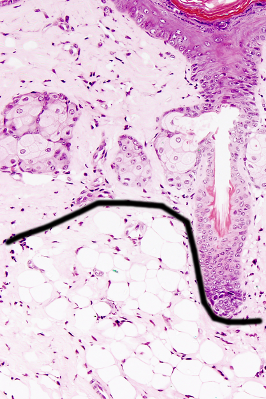|
These are the answers to the quiz. |
||
1) The integument is composed of bone and cartilage. It provides support to the animal body. | ||
| Not answered. The integument consists in the skin and derivatives, such as nails and scales. | ||
2) Thick epidermis and dermis are features of the thick skin. | ||
| Not answered. It is true. The thick skin is under heavy mechanical stress, so that it increases the thickness of dermis and epidermis for withstanding mechanical forces. | ||
3) The epidermis is made up of a cell type known as keratinocyte. | ||
| Not answered. It is true. Keratinocytes are the main cell type of the epidermis, although other cell types are also present, such as melanocytes and Merkel cells. | ||
4) Dermal papillae are abundant in the thin skin. | ||
| Not answered. It is false. Dermal papillae are folds of dermal connective tissue that intermingle with epidermal folds. This folded organization increases the contact surface between the epidermis and dermis, and it therefore gives a strong adhesion. Thus, these structures are observed in the thick skin. | ||
5) The papillary dermis is the deeper dermal layer. | ||
| Not answered. It is false. The papillary dermis is the outer dermal surface. The inner one is called reticular dermis. | ||
6) The hypodermis is found below the dermis, and contains many adipocytes. | ||
| Not answered. It is true. When there are many adipocytes forming a white fat depot, it is called adipose panicle. | ||
7) All body regions have hypodermis showing the same thickness. | ||
| Not answered. It is false. The thickness of the hypodermis is different depending on the body region, and it is also different between males and females. For example, in humans, the hypodermis is thick in the abdominal region, but it is very thin in the head.. | ||
8) Sebaceous glands release their content directly on the surface of the skin. | ||
| Not answered. It is false. Sebaceous glands are associated with the hair follicles, and release their products to hair canal. | ||
9) Epidermal crests are expansions of the epidermis toward the external part of the body. | ||
| Not answered. It is false. The epidermal crests are expansions of the epidermis toward de dermis, and are surrounded by the dermal papillae. They can be observed in the thick skin. . | ||
10) Mechanoreceptors that sense touching are mainly found in the dermis. | ||
| Not answered. It is true. There are many mechanoreceptors found in the dermis that perceive touching, such as Pacini receptors and Ruffini receptors. Free nerve terminal can be found in the epidermis that are able to sense temperature and mechanical pressures. | ||
11) Sweat glands are branched exocrine glands that release their content on skin surface. | ||
| Not answered. It is false. Although sweat glands release their content on the surface of the skin, they are not branched glands. | ||
12) Thermoregulation is one of the main function of the sweat glands. | ||
| Not answered. It is true. The evaporation of the sweat released onto the skin helps to reduce the body temperature. | ||
13) Nails are made up of living cells. | ||
| Not answered. It is false. Nails are compact layers of cornified dead keratinocytes. | ||
14) The epidermal region that generates the nail is called matrix. | ||
| Not answered. It is true. The matrix is a group of keratinocytes at the proximal area of the nail that produces waves cornified keratinocytes laid in layers. | ||
F-1) The dotted line separates epidermis from dermis. 
| ||
Not answered. It is false. The dotted line separates the dermis from the hypodermis. The blue line separates de epidermis from the dermis. Es falso. La línea negra marca el límite entre la dermis e hipodermis, mientras que la línea azul marca el límite entre la epidermis y la dermis | ||
F-2) Black arrows point to dermal papillae. 
| ||
Not answered. It is false. The black arrows point to the epidermal crests. The blue arrows point to the dermal papillae.  | ||
F-3) The stratum granulosum of the epidermis is delimited by black lines. 
| ||
Not answered. It is true. The stratum granulosum is a layer of keratinocytes in the process of becoming corneocytes (dead cells). In the stratum granulosum, keratinocytes show more granules and intensely stained with hematoxylin because of the basophilic properties of these granules.  | ||
F-4) In the figure D, it can be observed the matrix, that is, the epidermal region where the nail is produced. 
| ||
Not answered. It is false. The matrix can be observed in the figure C. In the figure D, the nail bed is observed. The nail grows over the nail bed, which is basically a nail anchoring region.  | ||
Results
Right answers = 0
Wrong answers = 0
Not answered = 18
Unusefull answers = 0
The score of the quiz (range between 0 and 10) = 0,0 Do you need to read the descriptive pages again ?